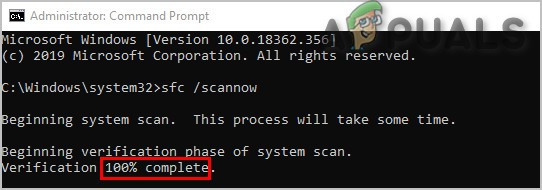After looking into this issue, we’ve discovered that there are actually multiple potential causes that might cause this error code on both Windows 10 and Windows 11. Here’s a list of potential culprits that you should troubleshoot against if you find yourself in the same kind of scenario: Now that you are familiar with every potential culprit that might be responsible for this issue, let’s dive into specifics and see how you can fix every potential scenario (step-by-step instructions below).
Run the Windows Update Troubleshooter
Before you move on to more advanced troubleshooting strategies, the ideal place to start is by running the Windows Update Troubleshooter and applying the recommended fix. Doing this might help you fix the issue automatically – as long as the problem is already covered by a repair strategy. Note: It’s worth mentioning that the Windows Update Troubleshooter on Windows 11 is much more capable than it is on Windows 10. The dozens of automated repair strategies that are added will boost your chances of fixing the issue automatically. If you haven’t tried running the Windows Update Troubleshooter yet, follow the instructions below for instructions on how to run it and apply the recommended fix: Note: The instructions below are universal and will work regardless of whether you’re on Windows 10 and Windows 11. In case you already tried running the Windows Update troubleshooter and you find that the issue is still not fixed, move down to the next potential fix below.
Remove remnants of old Macrium installation (if applicable)
According to some affected users, an old Macrium installation might be preventing the Windows Update from getting installed. This is reported to occur with both PCs where Macrium is currently installed and with PCs where Macrium was previously installed (and left behind some remnant files). Update: As it turns out, this issue can also appear immediately after you upgrade to Windows 11 on a PC where Macrium was installed on the older OS version. If you have Macrium Reflect installed on your PC (or you previously had it installed), follow the instructions below to get rid of any remnant files that might be currently causing this conflict. Here’s what you need to do: Note: If Macrium Reflect is already uninstalled, skip the first 4 steps and move directly to step 5. If the same kind of issue is still occurring even after you enforced the fix above (or this method was not applicable) move to the next potential fix below.
Deploy a CHKDSK scan
As it turns out, the Windows Update 0xc1420121 error can also be related to some type of inconsistency produced by a drive that is beginning to fail. This issue is mainly surfacing for Windows 10 and Windows 11 users that are still on traditional HDDs. What usually happens is, storage sectors used to store Windows files are beginning to fail as the storage device is slowly dying. If you’re dealing with this issue, the only long-term solution is to replace the drive with a new one (preferably an SSD since it’s much more reliable). But if that’s not the option, you can try using the Check Disk (CHKDSK) utility and see if it’s capable of replacing corrupted sectors with unused equivalents. Follow the instructions below to deploy a CHDKDSK scan and see if it ends up fixing the issue in your case: If you already tried deploying a CHKDSK scan and you’re still seeing the same 0xc1420121 error, move down to the next potential fix below.
Deploy SFC and DISM scans
If you’ve come this far and the 0xc1420121 error is still appearing when you’re attempting to install certain Windows Updates, you should start considering the fact that you might be dealing with some kind of system file corruption. If the corruption is superficial, you should be able to fix it by deploying SFC (System FIle Corruption) and DISM (Deployment Image Servicing and Management) scans in quick succession. Note: But keep in mind that this will only be effective as long as the corruption does not affect your kernel files. Start by deploying an SFC scan from an elevated CMD prompt and wait until the operation is complete. Once the operation is complete, restart your PC and wait for the next startup is complete. After your PC boots back up, open another elevated CMD prompt and deploy a DISM scan. Once the DISM scan is complete too, do one final restart and see if the problem is fixed. If it isn’t, move down to the final potential fix below.
Perform a repair install / clean install procedure
If you’ve come this far without a viable fix, chances are you’re dealing with some kind of system file corruption that you can’t fix conventionally. In this case, your very last option is to go for a procedure that will successfully replace every Windows file with an equivalent that you know is not tainted by corruption. When it comes to doing this, there are two ways word:
Clean install – Clean installing means you will essentially wipe the operating system drive and start fresh. This won’t require you to use compatible Windows installation media, but you’ll need to back up your data in advance if you don’t want to lose it permanently.Repair install – In case you have sensitive information on the same partition as your OS drive, the preferred approach should be to go for a repair install (in-place upgrade). This process will require you to use compatible installation media, but the main advantage is that you get to keep all personal files, media, games, and applications currently stored on the OS drive.
How to Fix Windows Update “Error Code: Error 0x800706ba”?How to Fix Windows Update Error Code 0x80070437 on Windows 10?How to Fix Windows Update “Error Code: 0x8024401c” on Windows 11?How to Fix Windows Update Error Code 0x80080005 on Windows 10












